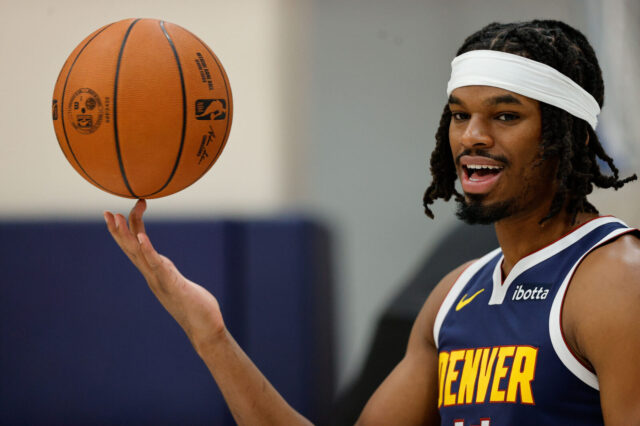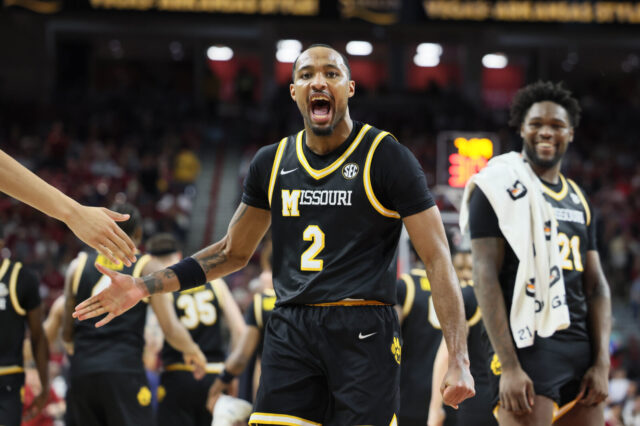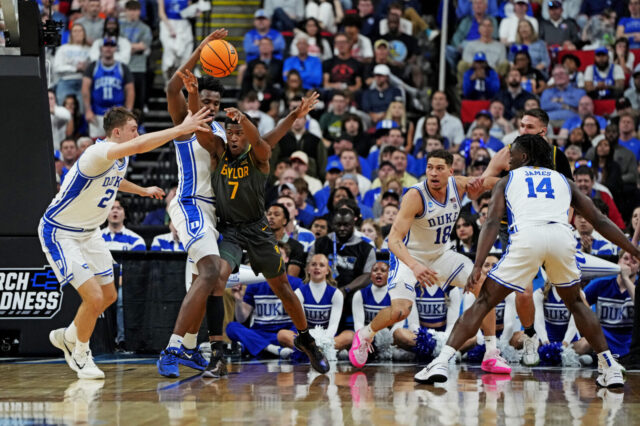With the NBA plunged head first into a lockout, this final edition of our Collective Bargaining series focuses on the owners precursor to this labor showdown – the NHL lockout of 2004-05.
It's hard to believe, but the idea of the NBA's lockout started all the way back in 2005.
Background
On July 22, 2005 the NHL Player’s Union and the NHL Owners ratified a new collective bargaining agreement after a 310 day lockout that wiped out the entire 2004-05 season. The new agreement was heavily tilted in favor of the owners, in which the owners gained what they wanted initially … a hard salary cap tied to league revenue (plus an additional 24% rollback in existing player contracts). Players retained guaranteed salaries, but at a heavy cost. The owners avoided anything more than a token revenue sharing obligation; where the top 10 grossing NHL teams split partial revenue among the lowest 10 grossing NHL teams.
The lockout was seen, at the time, as a victory for the NHL owners. They achieved “cost certainty” and managed to impose a hard-salary cap. While players retained guaranteed contracts the cap was in place (for the 2005-06 season the cap was set at $39 million per team) and the cap was tied to guarantee the players 54% of revenue (down from the neighborhood of 75% they were getting in the previous NHL CBA) against league wide revenue. Max player salaries are tied to percentage of team revenue and have risen considerably since 2005, but salaries can be bought out for a percentage based on a player’s age. So, the cap rose to $59 million for this past season (2010-11). Next season (2011-12) the NHL cap will be roughly $5 million higher. There is also a cap floor, which sets the least amount of money an owner is obligated to pay for team salary. This is roughly $16 million below the cap ceiling.
The NHL has experienced an unprecedented amount of parity since the advent of the hard-cap. With different teams winning the Stanley Cup every season since the CBA was signed. Let’s compare that time period to the NBA:
| NHL Champs (# times won – last year they won) | NBA Champs (# times won – last year they won) | |
| 2006 | Carolina Hurricanes (1st) | Miami Heat (1st) |
| 2007 | Anaheim Ducks (1st) | San Antonio Spurs (4th – 2005) |
| 2008 | Detroit Red Wings (11th – 2002) | Boston Celtics (17th – 1986) |
| 2009 | Pittsburgh Penguins (3rd – 1992) | Los Angeles Lakers (16th – 2002) |
| 2010 | Chicago Blackhawks (4th – 1961) | L.A. Lakers (17th – 2009) |
| 2011 | Boston Bruins (6th – 1972) | Dallas Mavericks (1st) |
Good times are being had by all…
… or are they?
NHL’s predicament and the lack of revenue sharing
The National Hockey League owners, much like their brethren in the NBA, are divided among large market and small market franchises. This was a major issue in the 1994 NHL lockout, which was considered a win for the NHL Players Association. The owners fractured on the issue of revenue sharing (luxury tax) and they ended up with a deal that they regretted. Fast forward to 2004. Determined to avoid the fracturing that marred their last attempt to lockout the players, the NHL large market owners were “appeased” by leaving out the subject of revenue sharing and the league focused almost entirely on player salaries and what they deemed as cost certainty. Commissioner Gary Bettman figured this was a way to keep his group of owners together while still going after their goals. A minor revenue sharing fix was added to the mix late in the contract proceedings, but it was nothing more than window dressing. Bettman’s strategy worked and the NHL players came back to the table with their tail between their legs and accepted an unprecedented 24% reduction in existing salaries.
Here we are in 2011 and the NHL is more competitive than ever (see the graphic above, again) and actual revenue has increased (as indicated by the salary cap growing more than $20 million in six seasons). Things couldn’t be better right?
When the NHL locked its players out in 2004 it was the owners claiming it must happen because many teams were on the verge of financial collapse (like the NBA’s New Orleans Hornets). The same remains true even after their deal was signed six seasons ago. Teams such as the Atlanta Thrashers (moving to Winnipeg, Canada for the 2011-12 season), Phoenix Coyotes, and Nashville Predators are on the border of financial solvency. Count the Tampa Bay Lightning and Carolina Hurricanes among the ones looming around the red (and the ‘Canes just won the title in 2006!). The value of the New York Islanders has plummeted. And the two time Stanley Cup champion Colorado Avalanche (1996 and 2001) have shed so much salary, that over the past two seasons the team has been hovering at, or near the salary cap floor.
Why is this still happening? Since their revenue sharing system is so poor, most NHL teams salary structure is linked almost exclusively to gate receipts and local TV deals. The league split $90 million in revenue this last season, but remember – with the Avs being a mid-market team they usually lose out on most of the revenue sharing dollars because most of that money goes to the bottom 10 revenue teams. And what meager revenue sharing there is out of the comparatively small national television package (NBC/Versus recently signed a package around $200 million annually [for 10 years], which sounds like a lot but in the grand scheme of TV packages it’s pretty small) is slanted toward the big market teams in New York, Boston, Los Angeles, Chicago, and Toronto. The strike really took a bite out of the casual fans’ interest in the NHL, preventing lucrative TV deals from being thrown at Bettman’s league. Also, NHL owners have been privately griping that they have to reach the salary cap floor (which is a bad sign if you are a fan of a team that is making those gripes).
Could the NHL’s reluctance to tackle real revenue sharing in 2004 be contributing to the remaining financial woes the league faces?
The NBA and the pursuit of economic parity
Much like the NHL in 2004, the NBA and its owners have been carefully planning their strategy for over a year. There’s been no confusion. The NBA Players Association has known that the NBA owners were walking down a very familiar path.
In recent counter-proposals the NBA has backed off its insistence on non-guaranteed contracts and introduced a “flex cap” which, as rightly deduced by the NBAPA is just a hard cap with some whipped cream on top. The lockout is assured because the new owners want to make some money on their investments without going through the bloody battle required to get real revenue sharing first. There is an enormous divide in the NBA between large market and small-to-mid-market teams. And there is a small group of NBA owners who also own NHL teams (Kroenke Sports Enterprises and Ted Leonsis, owner of the Washington Wizards and Capitals among those owners) wanting desperately to repeat their NHL success.
It makes sense that the owners would want to establish this system. It guarantees player costs and lowers the players’ Basketball Related Income (BRI) to under 40% in 10 years. If I was an owner – that is the sweetheart deal of sweetheart deals. They also know that the players won’t go for that sort of thing. We all understand, at this point, the small market teams feel slighted after LeBron James‘ decision last summer and the drama surrounding Carmelo Anthony just compounded things. The small markets want economic parity and a level playing field (from a competitive standpoint).
While these small market teams would definitely get a competitive playing field under their most recent proposal, economic parity (as we have seen) is far less assured by just cutting the bottom line. The fact remains that as long as the NBA is marketed as a star driven league, players will want to go play in large markets. They can make the most money there, not only in salary – but also with endorsements … and let’s not forget that large market teams can freely spend to bring in great teammates for their star players. Also, without increasing each team’s revenue streams via a real and robust revenue sharing plan, we will be right back where we started, much like the NHL is finding out now.
It is my opinion that the owners who have teams in both the NBA and NHL were fooled by their economic structure. Since their victory over the NHL players was so thorough in 2005 – it seems like it’s only natural to expect the same results. Yet, Billy Hunter, head of the NBAPA, is a much smarter leader than Bob Goodenow (former NHLPA Director). He understands that the owners are only tackling player salaries now because they don’t want the bloody fight among themselves over revenue sharing (until proven that they are actually talking about a revenue sharing plan it is highly doubtful any serious attempt is being made). By repeatedly forcing the owners to confront their own issues with themselves, Hunter has (maybe not intentionally) provided a window into the inequities that NBA owners have amongst themselves.
The owners must tackle the issue of contraction as well. NBA talent is spread too thin, and many teams are struggling, if not downright depressed economically (New Orleans). The players, meanwhile, must accept at least some of the economic responsibility to help out. It’s clear the current economic structure is not working, and just hoping for the status-quo won’t cut it. However, the tide of opinion has slowly turned the players way in these labor talks. If only because the NBA is coming off such a high in the ratings department. If the NBA disappears off the casual fans’ radar for too long what will be the repercussions? For the NHL it was the loss of national TV appearances, with NBC finally coming around a bit. No one can fathom what is to come.
This will be a very long summer. I don’t expect these issue to be resolved quickly.


